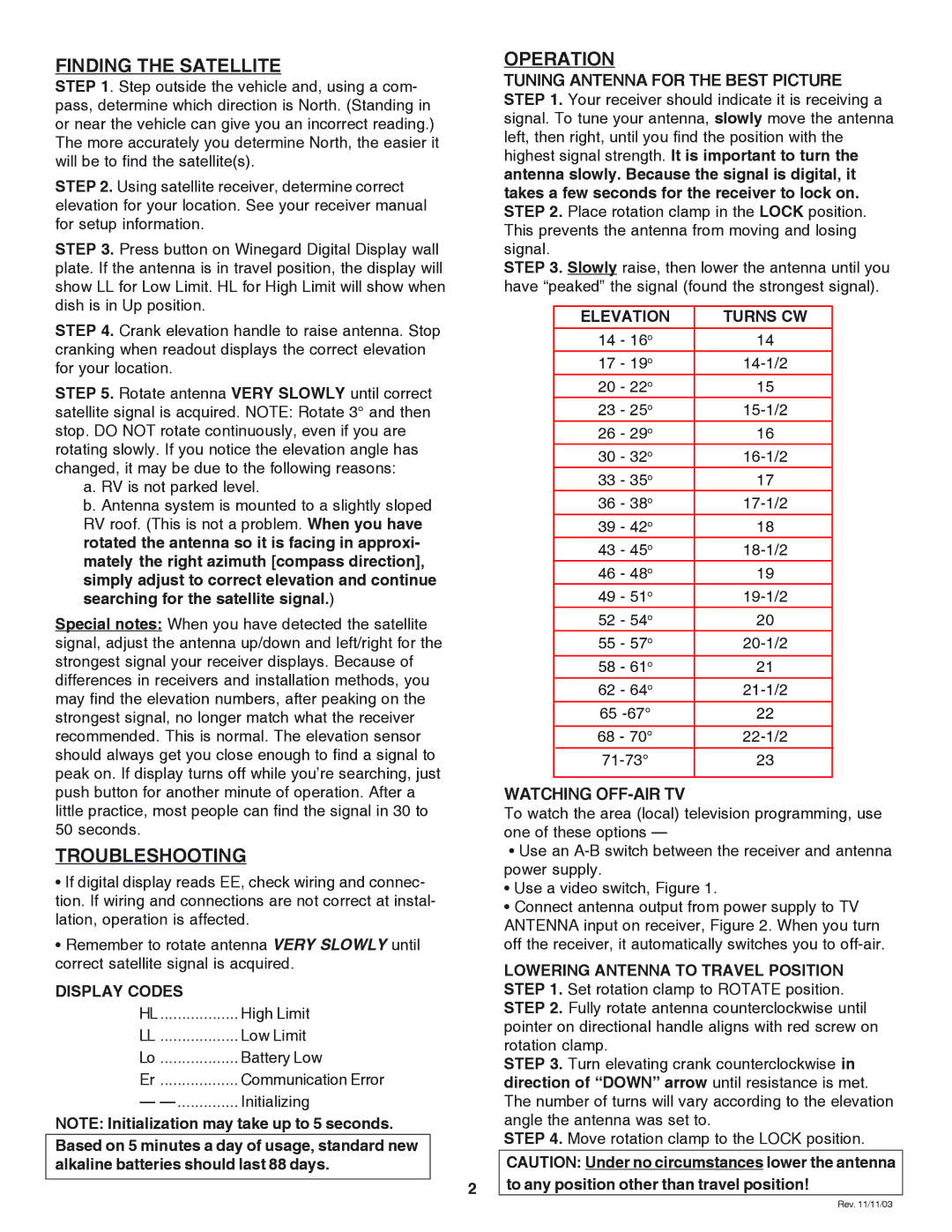
FINDING THE SATELLITE
STEP 1. Step outside the vehicle and, using a com- pass, determine which direction is North. (Standing in or near the vehicle can give you an incorrect reading.) The more accurately you determine North, the easier it will be to find the satellite(s).
STEP 2. Using satellite receiver, determine correct elevation for your location. See your receiver manual for setup information.
STEP 3. Press button on Winegard Digital Display wall plate. If the antenna is in travel position, the display will show LL for Low Limit. HL for High Limit will show when dish is in Up position.
STEP 4. Crank elevation handle to raise antenna. Stop cranking when readout displays the correct elevation for your location.
STEP 5. Rotate antenna VERY SLOWLY until correct satellite signal is acquired. NOTE: Rotate 3° and then stop. DO NOT rotate continuously, even if you are rotating slowly. If you notice the elevation angle has changed, it may be due to the following reasons:
a. RV is not parked level.
b. Antenna system is mounted to a slightly sloped RV roof. (This is not a problem. When you have rotated the antenna so it is facing in approxi- mately the right azimuth [compass direction], simply adjust to correct elevation and continue searching for the satellite signal.)
Special notes: When you have detected the satellite signal, adjust the antenna up/down and left/right for the strongest signal your receiver displays. Because of differences in receivers and installation methods, you may find the elevation numbers, after peaking on the strongest signal, no longer match what the receiver recommended. This is normal. The elevation sensor should always get you close enough to find a signal to peak on. If display turns off while you’re searching, just push button for another minute of operation. After a little practice, most people can find the signal in 30 to 50 seconds.
TROUBLESHOOTING
•If digital display reads EE, check wiring and connec- tion. If wiring and connections are not correct at instal- lation, operation is affected.
•Remember to rotate antenna VERY SLOWLY until correct satellite signal is acquired.
DISPLAY CODES |
|
HL | High Limit |
LL.................. Low Limit Lo .................. Battery Low
Er .................. Communication Error
—
NOTE: Initialization may take up to 5 seconds.
Based on 5 minutes a day of usage, standard new alkaline batteries should last 88 days.
2
OPERATION
TUNING ANTENNA FOR THE BEST PICTURE
STEP 1. Your receiver should indicate it is receiving a signal. To tune your antenna, slowly move the antenna left, then right, until you find the position with the highest signal strength. It is important to turn the antenna slowly. Because the signal is digital, it takes a few seconds for the receiver to lock on. STEP 2. Place rotation clamp in the LOCK position. This prevents the antenna from moving and losing signal.
STEP 3. Slowly raise, then lower the antenna until you have “peaked” the signal (found the strongest signal).
ELEVATION | TURNS CW |
|
|
14 - 16o | 14 |
17 - 19o | |
20 - 22o | 15 |
23 - 25o | |
26 - 29o | 16 |
30 - 32o | |
33 - 35o | 17 |
36 - 38o | |
39 - 42o | 18 |
43 - 45o | |
46 - 48o | 19 |
49 - 51o | |
52 - 54o | 20 |
55 - 57o | |
|
|
58 - 61o | 21 |
62 - 64o | |
|
|
65 | 22 |
|
|
68 - 70° | |
23 | |
|
|
WATCHING OFF-AIR TV
To watch the area (local) television programming, use one of these options —
•Use an
•Use a video switch, Figure 1.
•Connect antenna output from power supply to TV ANTENNA input on receiver, Figure 2. When you turn off the receiver, it automatically switches you to
LOWERING ANTENNA TO TRAVEL POSITION STEP 1. Set rotation clamp to ROTATE position. STEP 2. Fully rotate antenna counterclockwise until pointer on directional handle aligns with red screw on rotation clamp.
STEP 3. Turn elevating crank counterclockwise in direction of “DOWN” arrow until resistance is met. The number of turns will vary according to the elevation angle the antenna was set to.
STEP 4. Move rotation clamp to the LOCK position.
CAUTION: Under no circumstances lower the antenna to any position other than travel position!
Rev. 11/11/03
